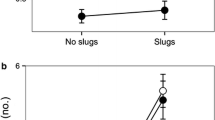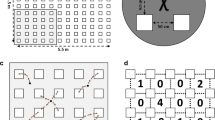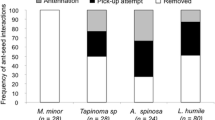Abstract
Invasive ants threaten native communities, in part, through their potential to disrupt mutualisms, yet invasive species may also facilitate native species. The red imported fire ant (Solenopsis invicta) is one of the most conspicuous invasive ants in North America and its high densities, combined with its potential to displace native ants, have led to concerns that it may disrupt ant-plant seed dispersal mutualisms. We examined the potential of fire ants to disperse seeds in the longleaf pine ecosystem by comparing the removal of elaiosome-bearing seeds by fire ants versus native ants. A total of 14 ant species were observed removing seeds, with fire ants responsible for more than half of all removals. While fire ants were the dominant seed remover in this system, they did not remove significantly more seeds than would be expected based on their population density (46% of ground-dwelling ants). Moreover, red imported fire ants were similar to native ants with respect to distance of seed movement and frequency of moving seeds back to the nest. Areas of higher fire ant densities were found to have greater rates of seed removal by ants without a subsequent drop in seed dispersal by native ants, suggesting that fire ant-invaded areas may experience overall higher levels of seed dispersal. Thus, fire ants may actually facilitate dispersal of elaiosome-bearing plant species in the longleaf pine ecosystem.





Similar content being viewed by others
References
Andersen AN (1988) Dispersal distance as a benefit of myrmecochory. Oecologia 75:507–511
Berg RY (1975) Myrmecochorous plants in Australia and their dispersal by ants. Aust J Bot 23:475–508
Bond W, Slingsby P (1984) Collapse of an ant-plant mutalism: the Argentine ant (Iridomyrmex humilis) and myrmecochorous Proteaceae. Ecology 65:1031–1037
Buren WF (1972) Revisionary studies on the taxonomy of the imported fire ants. J Georgia Entomol Soc 7:1–26
Callaway RM (1995) Positive interactions among plants. Bot Rev 61:306–349
Callcott AMA, Collins HL (1996) Invasion and range expansion of imported fire ants (Hymenoptera: Formicidae) in North America from 1918–1995. Fla Entomol 79:240–248
Carney SE, Byerley MB, Holway DA (2003) Invasive Argentine ants (Linepithema humile) do not replace native ants as seed dispersers of Dendromecon rigida (Papaveraceae) in California, USA. Oecologia 135:576–582
Christian CE (2001) Consequences of a biological invasion reveal the importance of mutualism for plant communities. Nature 413:635–639
Clewell AF (1989) Natural history of wiregrass (Aristida stricta Michx., Gramineae). Nat Area J 9:223–233
Culver DC, Beattie AJ (1978) Myrmecochory in Viola: dynamics of seed-ant interactions in some West Virginia species. J Ecol 66:53–72
Goebel PC, Palik BJ, Kirkman LK, Drew MB, West L, Pederson DC (2001) Forest ecosystems of a lower Gulf Coastal Plain landscape: multifactor classification and analysis. J Torrey Bot Soc 128:47–75
Gómez C, Pons P, Bas JM (2003) Effects of the Argentine ant Linepithema humile on seed dispersal and seedling emergence of Rhamnus alaternus. Ecography 26:532–538
Gotelli NJ, Arnett AE (2000) Biogeographic effects of red fire ant invasion. Ecol Lett 3:257–261
Gove AD, Majer JD, Dunn RR (2007) A keystone ant species promotes seed dispersal in a “diffuse” mutualism. Oecologia 153:687–697
Hacker SD, Gaines SD (1997) Some implications of direct positive interactions for community species diversity. Ecology 78:1990–2003
Heithaus ER (1981) Seed predation by rodents on three ant-dispersed plants. Ecology 62:136–145
Holway DA (1999) Competitive mechanisms underlying the displacement of native ants by the invasive Argentine ant. Ecology 80:238–251
Holway DA, Suarez AV (1999) Animal behavior: an essential component of invasion biology. Trends Ecol Evol 14:328–330
Hughes L, Westoby M (1992) Fate of seeds adapted for dispersal by ants in Australian sclerophyll vegetation. Ecology 73:1285–1299
Human KG, Gordon DM (1996) Exploitation and interference competition between the invasive Argentine ant, Linepithema humile, and native ant species. Oecologia 105:405–412
Kalisz S, Hanzawa FM, Tonsor SJ, Thiede DA, Voigt S (1999) Ant-mediated seed dispersal alters pattern of relatedness in a population of Trillium grandiflorum. Ecology 80:2620–2634
Lach L (2003) Invasive ants: unwanted partners in ant-plant interactions? Ann Mo Bot Gard 90:91–108
Levey DJ, Byrne MM (1993) Complex ant-plant interactions: rain-forest ants as secondary dispersers and post-dispersal seed predators. Ecology 74:1802–1812
Majer JD (1978) An improved pitfall trap for sampling ants and other epigaeic invertebrates. J Aust Entomol Soc 17:261–262
Manzaneda AJ, Fedriani JM, Rey PJ (2005) Adaptive advantages of myrmecochory: the predator-avoidance hypothesis tested over a wide geographic range. Ecography 28:583–592
Morris JR, Steigman KL (1993) Effects of polygyne fire ant invasion on the native ants of a blackland prairie in Texas. Southwest Nat 38:136–140
Morrison LW (2000) Mechanisms of interspecific competition among an invasive and two native fire ants. Oikos 90:238–252
Ness JH (2004) Forest edges and fire ants alter the seed shadow of an ant-dispersed plant. Oecologia 138:448–454
Porter SD, Savignano DA (1990) Invasion of polygyne fire ants decimates native ants and disrupts arthropod community. Ecology 71:2095–2106
Ready CC, Vinson SB (1995) Seed selection by the red imported fire ant (Hymenoptera: Formicidae) in the laboratory. Environ Entomol 24:1422–1431
Rodriguez LF (2006) Can invasive species facilitate native species? Evidence of how, when, and why these impacts occur. Biol Invasions 8:927–939
Rodriguez-Cabal MA, Stuble KL, Nuñez MA, Sanders NJ (2009) Quantitative analysis of the effects of the exotic Argentine ant on seed dispersal mutualisms. Biology Letters 5:499–502
Sax DF, Kinlan BP, Smith KF (2005) A conceptual framework for comparing species assemblages in native and exotic habitats. Oikos 108:457–464
Stachowicz JJ (2001) Mutualisms, facilitation, and the structure of ecological communities. Bioscience 51:235–246
Stuble KL, Kirkman LK, Carroll CR (2009) Patterns of abundance of fire ants and native ants in a native ecosystem. Ecol Entomol 34:520–526
Wilson EO, Brown WL (1958) Recent changes in the introduced population of the fire ant Solenopsis saevissima (Fr Smith). Evolution 12:211–218
Xiong Y, Chen J-D, Gu Z-Y, Wu X-H, Wan F-H, Hong X-Y (2008) The potential suitability of Jiangsu Province, east China for the invasive red imported fire ant, Solenopsis invicta. Biol Invasions 10:475–481
Zettler JA, Spira TP, Allen CR (2001) Ant-seed mutualisms-can red imported fire ants sour the relationship? Biol Conserv 101:249–253
Acknowledgments
We thank R. Wyatt for providing feedback during the preparation of this manuscript and L.M. Conner for statistical advice. Additional thanks go to J.R. King and an anonymous reviewer for providing comments on a later version of this manuscript. Financial support was provided by the J.W. Jones Ecological Research Center, the R.W. Woodruff Foundation, and the University of Georgia.
Author information
Authors and Affiliations
Corresponding author
Rights and permissions
About this article
Cite this article
Stuble, K.L., Kirkman, L.K. & Carroll, C.R. Are red imported fire ants facilitators of native seed dispersal?. Biol Invasions 12, 1661–1669 (2010). https://doi.org/10.1007/s10530-009-9579-0
Received:
Accepted:
Published:
Issue Date:
DOI: https://doi.org/10.1007/s10530-009-9579-0




